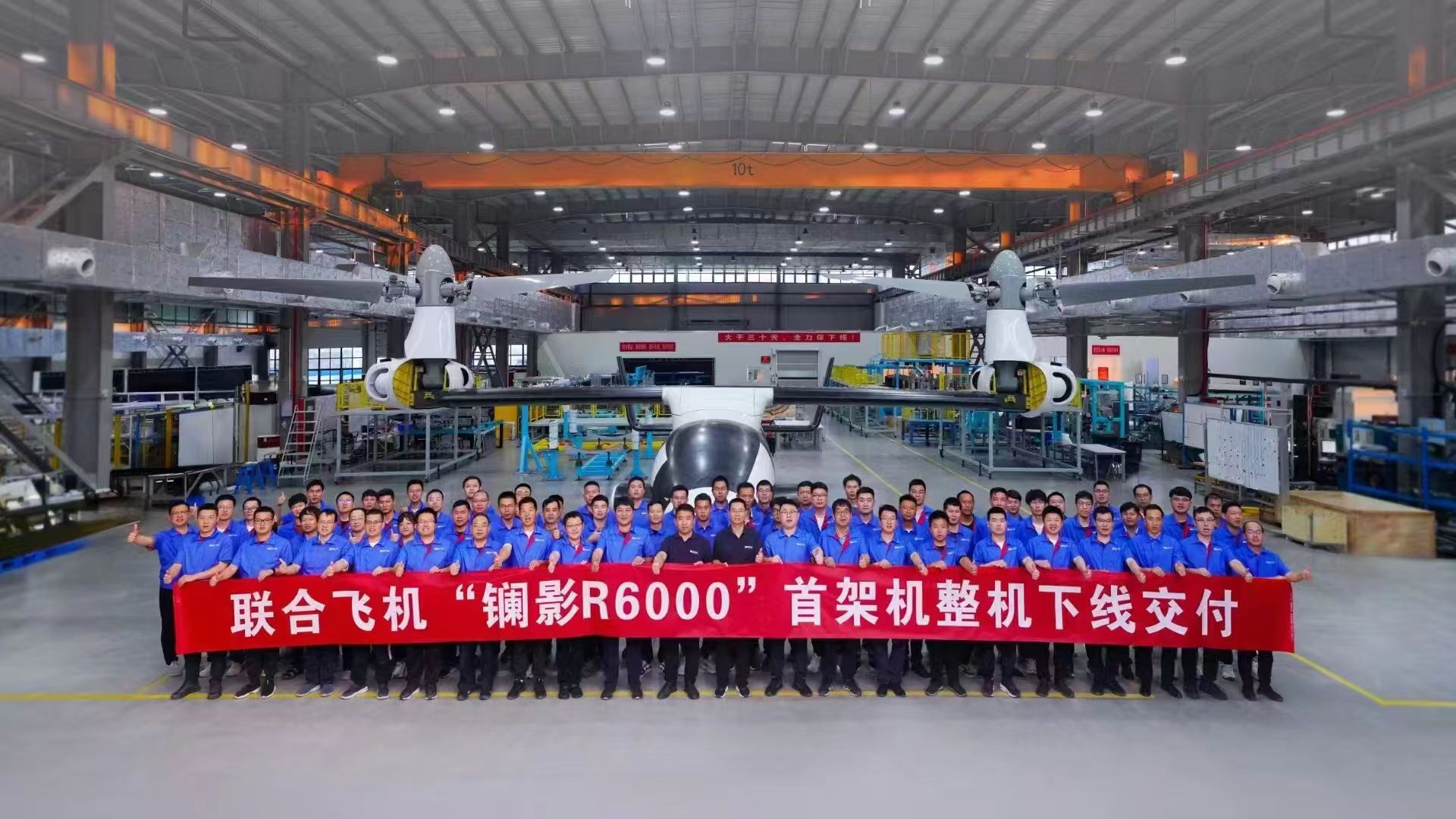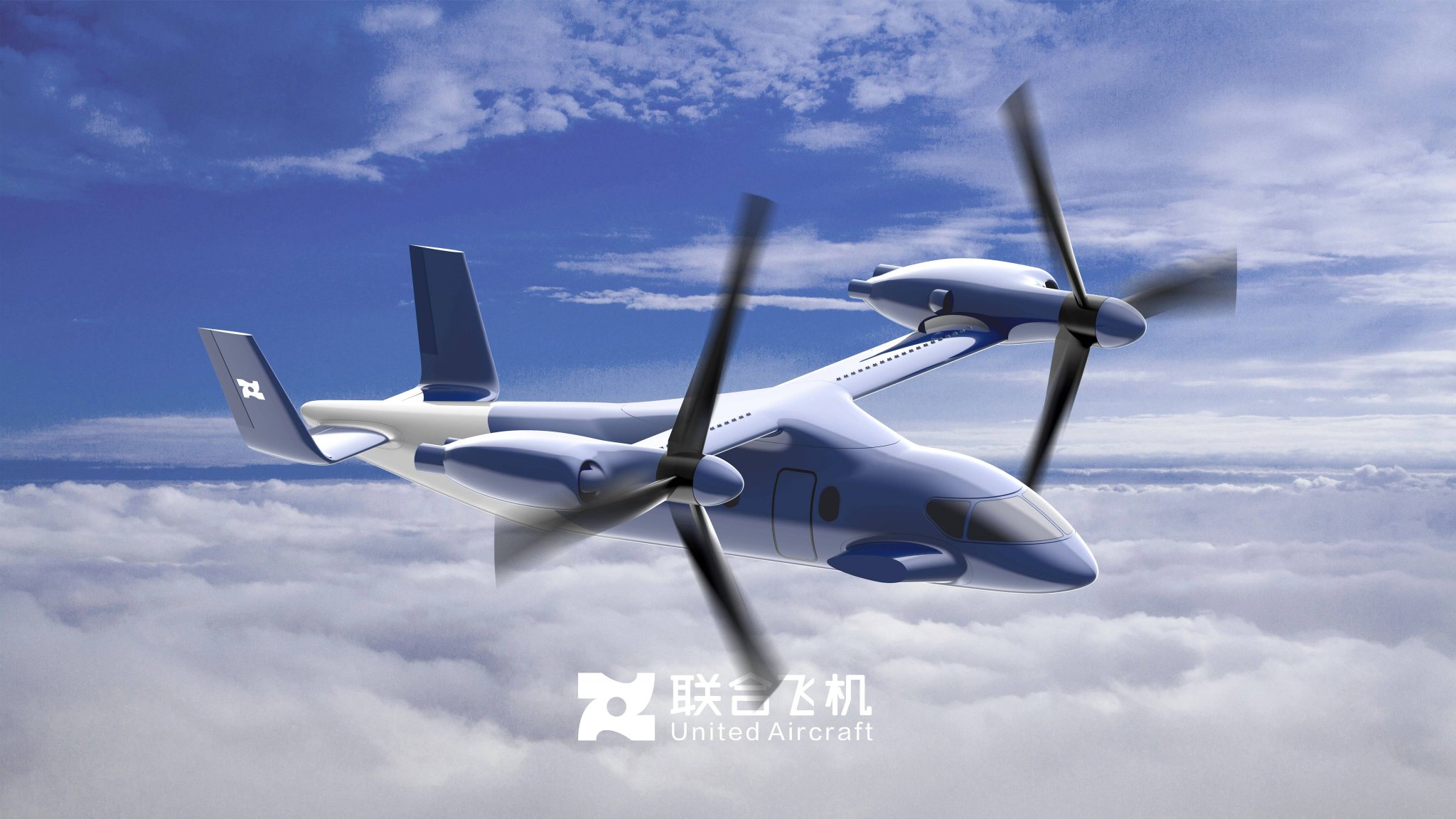China has once again grabbed global attention with the debut of its latest aviation innovation—the Zhang Ying R6000 (also known as UR6000).
R6000, a 6-metric-ton tiltrotor drone produced by Chinese OEM United Aircraft Wuhu Aviation Industrial Park in China’s eastern Anhui province, showcases China’s cutting-edge advancements in aerospace.
Designed for civilian missions like cargo and passenger transport, the R6000 underscores China’s growing ambitions in aviation technology and its strategic push toward civil-military integration.
A photo shared by United Aircraft on October 11 reveals what is said to be the first completed UR6000 prototype on the production line. A placard proudly declares it “the first machine delivered off the line.”

What Is Tiltrotor Technology?
A tiltrotor drone combines helicopter and airplane technology. It’s an unmanned aerial vehicle (UAV) that can take off and land vertically like a helicopter but also fly forward like a plane.
During take-off and landing, its rotors point straight up, allowing it to hover like a helicopter. Once airborne, the rotors tilt horizontally, enabling it to transition into forward flight.
This means it doesn’t need a runway to take off or land, yet it can still cover long distances quickly and efficiently. It’s often called a ‘hybrid VTOL drone’ because it switches between vertical and forward flight by adjusting the position of its rotors.
Features of the R6000
The R6000 is hailed as the world’s first 6-ton-class tiltrotor, marking China’s initial venture into the large tiltrotor segment.
This innovative aircraft features a high-wing configuration with constant-chord wings and tiltable rotors mounted on fixed engine pods at the tips of the wings. Each engine is equipped with three-blade rotors, while the forward section of the fuselage incorporates canard surfaces.
A large cargo door is positioned on the port side toward the rear of the fuselage, and the AAV boasts a U-shaped empennage configuration with two horizontal and two vertical stabilizers.
Designed to accommodate ten passengers, this revolutionary tiltrotor targets civilian applications such as cargo and passenger transport.
According to the company, the R6000 boasts a maximum take-off weight of 6,100 kg and a commercial payload capacity of 2,000 kg. It offers an impressive cruising speed of 550 km/h, a service ceiling of 7,620 m, and a maximum flight distance of 1,500 km.

With its substantial payload capacity and advanced autonomous systems, the R6000 sets new benchmarks in UAV technology. Although the specifics of its engines remain undisclosed, the R6000 is expected to be powered by turboshaft engines.
According to a Janes report, each engine is anticipated to be rated between 1,500 and 2,000 horsepower, and a variable-speed gearbox will be employed to manage the varying power needs for vertical and horizontal flight modes.
Its cutting-edge technical specifications distinguish it from traditional aircraft, positioning the R6000 to redefine long-range UAV standards. It is capable of transporting passengers or cargo at unprecedented speeds and altitudes for an uncrewed aircraft of this size.
United Aircraft: The Innovators
While Chinese private aerospace firm United Aircraft may not be among the largest in the country, it boasts significant experience in designing and building rotary-wing drones.
The company has developed both smaller quadcopters and larger drones with coaxial rotor arrangements, primarily aimed at logistics, surveillance, firefighting, and emergency response.
The R6000 project builds on United Aircraft’s previous successes in developing uncrewed coaxial helicopters for firefighting and emergency operations. Models like the 600-kg TD550 and the 350-kg TD220 have established the company as a leader in autonomous systems.
A decade ago, the TD220’s flight tests, conducted under the guidance of founder Tian Gangyin, enabled United Aircraft to secure a major military contract, enhancing its reputation in the Chinese aviation industry.
This expertise in autonomous systems has been crucial in the R6000’s development, which incorporates innovative design elements to optimize both vertical and horizontal flight.
From Concept To Reality
Development of United Aircraft’s UR6000 tiltrotor Autonomous Aerial Vehicle (AAV) reportedly began in 2021. China first showcased the concept at the Singapore Airshow in February 2024. By the third quarter of 2024, the R6000 rolled off the assembly line.
According to reports, a full-scale prototype is expected to be formally unveiled at the Zhuhai Air Show later in 2024, with full certification anticipated by 2027.
China’s Civil-Military Integration
The tiltrotor’s innovative design, coupled with China’s civil-military integration policy, highlights its dual-use potential for both civilian and military missions.
In an interview with ‘Janes,’ a United Aircraft official stated that “the R6000 AAV is a fully autonomous platform designed for cargo and passenger transport applications.” While the tiltrotor drone is currently marketed for civilian use, its military applications are undeniably apparent.
In fact, one image on United Aircraft’s website features the UR6000 adorned with People’s Liberation Army (PLA) markings, signaling the company’s commitment to a military-civil integration strategy.
Although the R6000 was initially intended for civilian missions, it possesses clear military potential. Its capabilities have drawn the attention of defense analysts worldwide, especially given the company’s recent successes in the military sector.
It can easily adapt for military purposes such as troop transport, supply delivery, or reconnaissance missions.
The R6000’s potential to blur the lines between civilian and military uses underscores China’s broader strategy of leveraging dual-use technologies to strengthen both sectors.
Through this innovation, China not only showcases its technological prowess in civil aviation but also expands the boundaries of how these technologies can be applied in military contexts.
As a forward-looking tiltrotor model, the R6000 epitomizes United Aircraft’s vision of merging military and civilian technology, setting the stage for a new era in dual-use aviation.
Strategic Implications
The tiltrotor is poised to join an expanding family of fixed-wing Chinese transport drones designed for dual civilian and military applications. It is well-suited for various missions, especially in the Indo-Pacific theater, where access to conventional airstrips may be restricted during wartime.
This capability is crucial for delivering cargo to remote locations, such as Chinese island outposts in the South China Sea.
As China continues to merge civilian and military technologies, the R6000 is set to become a vital asset in the country’s aviation portfolio, pushing the limits of what unmanned aerial systems can achieve.
This innovative approach not only enhances operational flexibility but also underscores China’s commitment to advancing its capabilities in both civilian and military aviation.
- Shubhangi Palve is a defense and aerospace journalist. Before joining the EurAsian Times, she worked for E.T. Prime. In this capacity, she focused on covering defense strategies and the defense sector from a financial perspective. She offers over 15 years of extensive experience in the media industry, spanning print, electronic, and online domains.
- Contact the author at shubhapalve (at) gmail.com




